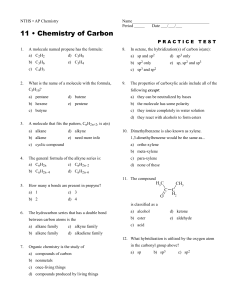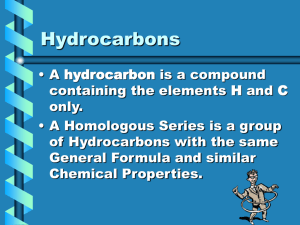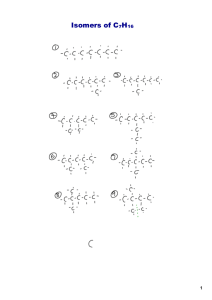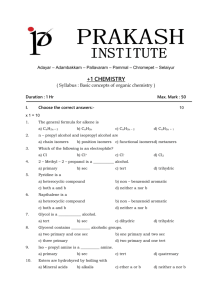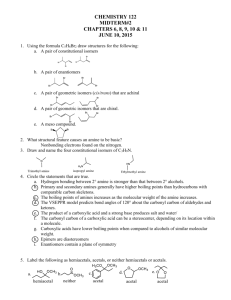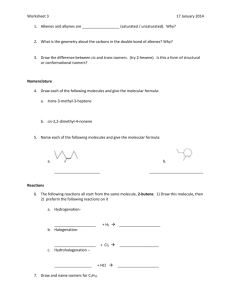Zumd22
advertisement
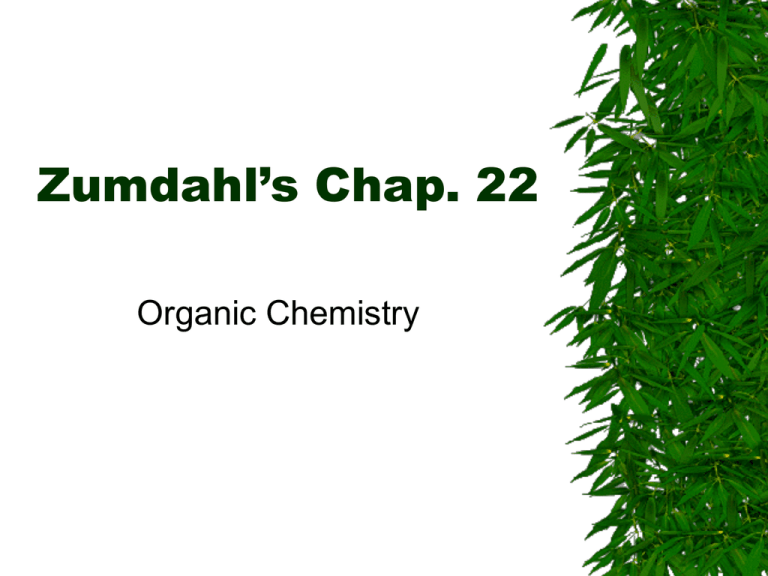
Zumdahl’s Chap. 22 Organic Chemistry Chapter Contents Introduction Alkanes CnH2n+2 – Isomers – Nomenclature – Cycloalkanes CnH2n Alkenes CnH2n Alkynes CnH2n–2 Aromatics Functional Groups – – – – – – Alcohols Aldehydes Ketones Carboxylic Acids Esters Amines Organic Chemistry Once upon a time … – It was believed that organic chemicals could only arise in life processes … – That they were a product of life’s vitality. In 1828, German chemist Friedrich Wöhler dispelled that myth when ammonium cyanate, NH4CNO, heated gave (organic) urea, (NH2)CO(NH2). – (Mineral) As if we needed another source. Modern Views With the exception of petroleum products, geological and elemental carbon is inorganic carbon. Other carbon-containing molecules are organic by virtue of carbon’s presence. There are no end to the combinatorial possibilities since C bonds to C! Carbon’s Flexibility sp, sp2, sp3 mean a rich geometry of 180°, 120°, and 109.43° angles in virtually endless chains and branches of organic molecules. The most potent psychotropic chemical cocktail on Earth … CHOCOLATE! Carbon’s Reactivity NOT. With the exception of unsaturated sites (multiple carbon-carbon bonds), it is at the heteroatoms (non-CH atoms, X) in an organic molecule where lies the reactive site. Common CX combinations are called functional groups and dictate reactivity. Inorganic Carbon Elemental carbon – Graphite – Diamond – Buckminsterfullerene Carbon oxides and halides Carbonates and carbides Simple cyano- compounds like HCN. ALKANES Saturated hydrocarbons, CnH2n+2. – “Saturated” because they can’t take any more hydrogen atoms! – Straight chains are H3C–(CH2)n–2–CH3 – Gaseous for n<5; solid for n>17 @ STP. – Inert (but for strong oxidizers) – Pathologically nonpolar. – Waxes, oils, & fuel gases as n decreases. Old Possum’s Naming After n=4, the prefixanes have Greek numbers as their prefixes. – 5=pent, 6=hex, 7=hept, 8=oct, 9=non, and 10=dec, 20=eicos, 30=triacos But n4 are named historically – CH4, Methane (“intoxicate” from the Greek) – Ethane, Propane, and Butane for 2,3,4. Branching & Isomers After n=3, it’s possible to let some C’s bond with more than 2 other carbons. – But fewer than 5, of course! – The # of structural isomers possible thereby grows exponentially with n. – These isomers have similar chemical and physical properties. – So they’re a bit expensive to separate, and one sees bottles labeled merely “hexanes.” Isomer Naming Older conventions would have that as “isooctane,” but a good IUPAC name results from the following: – Name the longest C chain (pentane) – List the side groups in alphabetical order with Greek prefixes (trimethylpentane) – Supply (smallest possible) positional indices (2,2,4 trimethylpentane) – The gasoline power rating standard molecule. Cycloalkanes, CnH2n If the two end C’s lose 1 H each, they have free valence to close a ring; voila, cyclo(whatever)ane. – Again properties similar to straight chains. – Can now have conformational isomers! – E.g., BOAT cyclohexane versus CHAIR See the C3 and S6 here? Alkenes, CnH2n Cycle formation isn’t the only possible result of dehydrogenation. Adjacent C’s can double bond, C=C, making an (unsaturated) alkene. – Much more reactive (vulnerable e– pair) – Rigid orbitals rigid planar partners! – E.g., trans-5-methyl-2-hexene Obligatory plane seen edge on Alkene Isomers While an sp3 CX2Y2 has only 1 isomer, (every X and Y is adjacent to all the others) the sp2 alkene C2X2Y2 has cis & trans isomers (where X is or isn’t on the same side of = as X). – For longer hydrocarbons, cis & trans refer to the side the chain extends: cis for the same side and trans for the opposite cis-2-butene trans-2-butene Alkynes, CnH2n–2 propyne sp triple bonding makes a rigid 180° segment in a hydrocarbon. It too is vulnerable to attack across the multiple bond site. – Double & triple bonds can suffer addition where an AB molecule single bonds A and B to an unsaturated site. H2, HX, and X2 (where X is halogen) are favorites. anthracene (edge on) bromobenzene Unsaturated Cycles Earlier we noted the stability lent to benzene, C6H6, by MOs. Alternating single/double cycles occur in many organic molecules similarly. – This class is called “aromatic” (by virtue of their aroma). – The structure is often preserved in their chemical reactions; they don’t add, they substitute instead. isobutraldehyde or methylpropanal Functional Groups Organic backbones can bear heteroatoms as reactive sites. Alkyl root symbolized as R, a generic hydrocarbon radical (methyl, ethyl, etc.) Functional groups append R, e.g., R–OH, an alcohol, or R–CHO, aldehyde. R–CO2H, a carboxylic acid, R–NH2, amine. Alcohols, R–OH The –OH makes alcohol polar enough to hydrogen bond. water soluble Fermentation product but vulnerable to oxidation to aldehyde and acid. yeast +2 2 glucose, C6H12O6 ethanol CO2 O C H Aldehydes, R–CHO Next C oxidation state up from alcohol. – Degradation product in your liver! If C=O isn’t a chain end substituent, it’s not an aldehyde but a ketone. Aldehydes are often flavorings, but Ketones are industrial solvents. quinone benzaldehyde, “bitter almond” O C O–H Carboxylic Acids R–CO2H Usual highest C ox. state in organics. End product of body’s alcohol degradation. Weakly acidic but important buffers. React with alcohols to make highly flavorful esters … a condensation rxn. + butanoic acid “rancid yak butter” ethanol + ethyl butyrate “pineapple” water Amines, Rn–NH3–n Come in three varieties, n = 1, 2, & 3. – “Primary” amines, n=1, are at chain end. – “Secondary” amine N bonds to 2 carbons. – “Tertiary” amines bond to 3 C. – Weak base Kb diminishes as n increases. Alcohols are also primary, secondary, and tertiary. (Primary are on end carbons.) – But this refers to the bonding of the C to which OH is attached. Coniine (2ndary) “hemlock” 2-propyl-piperidine Mixed Functionality So H2NCH2CH2OH is an alcohol and an amine; it becomes ethanolamine. But the monster C9H14N4O3 would be agony to call by its IUPAC name. – So it’s known by it common name, carnosine. How many Ka and Kb are expected? 1 and 4, respectively.
